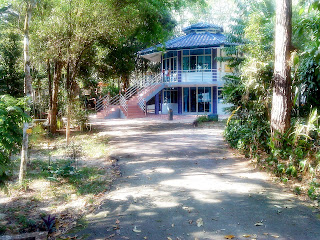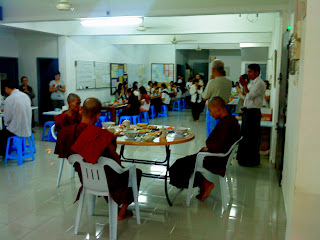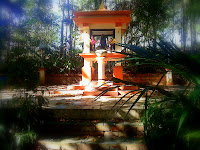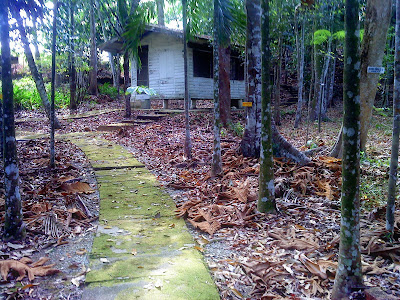This year, I did not go back to my family in northen Malaysia. I made a prior arrangement to spend the long weekend holidays (about 5 days) at a place totally unknown to me. Equipped with unshakable determination, I managed to locate this very special place in Kota Tinggi, Johor. It’s called Santisukhārāma Meditation Centre (Hermitage of Peaceful Bliss).
 |
| The main building at the Santisukharama Meditation Centre |
 |
| The Sima Hall |
 |
| The blissful greeting at the entrance |
Sister Sam is a retired teacher. As a person of utmost responsibility and commitment to the place, she seems to run the place nearly from head to toe. Somehow she was very supportive to my presence there “to practise meditation”. She got me listening to talks and Vipassana meditation instructions from the Ven Sujiva which were played from a CD. It was indeed an outright effort of hers to set things right from the beginning.
I had a chance to bump into the resident monk at Santisukharama. It was at a later period when I went back to Singapore that I got to know his name. His name is Bhante Mahacara. I had never met him before, but it seemed that there was an unknown reason of him being so enthusiastic in guiding me some basic Vipassana meditation techniques.
Basically, Santisukhārāma follows Ven Mahasi Sayadaw’s tradition which focuses on the rising and falling movement of abdomen as the meditation object. I told him that I was more familiar with Samatha and Ānāpānasati method. According to him, practising Samatha ultimately results in pure tranquility or total calmness, but Vipassana makes you “see” the interaction between body and mind, and ultimately the 3 Universal Characteristics of the whole thing which give rise to insight. Mindfulness of “in-out breath” at the nose tip could also be used, but at the end of the day, it is the sensation of the area around nostrils that matter.
 |
| "Mindfully observing the rise and fall of the abdomen..." |
He further elaborated on how walking meditation should be rightfully done: simply just label all movements of the feet as “raising”, “lifting”, “pushing”, “dropping”, “treading” and “pressing”. Just label them first. I was also instructed to note the “intention” to stop and change the course of my walking. “Just note the intention, and see what happens next. Everything that happens must come from an intention behind, just like the law of cause and effect. There’s no ‘I’ or ‘Me’ in your walking, it’s just the interaction between mind and matter”, those were what he told me in which I could recall.
He was so keen to guide me further, to the extent that he reconsidered his plan to leave this place. He wished to stay back to monitor my progress. I was truly overwhelmed by his noble intention, for I was doubting my own ability to follow closely his personal guidance. But when I told him that my stay was not for long, he then reverted back to his original plan of leaving for Johor Bharu.
One way or another, I always believe that when you are persisting in doing something wholesome, all the the wholesome people and things will come to support you.
My first night was a bit of a torture. I was aware that there will be no dinner served at the centre, only breakfast (at 7am) and lunch (at 11am) will be served due to the observance the 8 precepts. But I was not really prepared for that, my tummy cried the whole night and I could hardly sleep. It was indeed a regret of not sneaking in some snacks to the hermitage earlier to survive throughout the night!
“Hissing” in the midst of gentle breeze, dropping leaves like a curtain of endless length, with birds chirping “mindfully” in between the branches: thanks to the life-giving trees in the centre compound. There are so many trees, so many species, perhaps over 200 of them. Ven Sujiva quoted a cleric in his recent book: “The man who plants trees goes to Heaven.”
The Mahasi’s technique is relatively new to me. I faithfully applied the technique for my Vipassana practice there. Generally, the main distinguishing features of the approach compared to Samatha are the large extent use of body contemplation with the main object used is the “rising-faling” of the abdomen; mindful noting of each process; and walking meditation alternated with sitting, one hour at a time. I found the techniques were so refreshing, galvanising a new venture into the inner discovery for a beginner like myself.
The mindful awareness was largely paid on the rising-falling motion of the abdomen. As it is the grosser bodily activity, I found it easier to place my awareness on the object compared to the in-out breath at nostrils (the Ānāpānasati method). According the Ven Sujiva’s book, “The Tree of Wisdom, The River of No Return: The practice and development on insight meditation”, the priority of object can be changed: when the rising-falling of abdomen becomes unclear, one can switch the attention to sitting/touching sensations, or pain, or thinking processes, and the abdominal movement becomes the secondary object. The main purpose here is to keep the continuity flow of mindfullness. The instruction went on stating that one should not only keep the mind concentrated, but mindful observation on the nature of bodily sensations should also be attempted, and picked up with clear perception of the qualities of the material elements.
Usually I could sit for a full hour, unless sleepiness sneaked in, I would switch the “posture mode” to walking meditation. I discovered that sloth and torpor was the main culprit for my wandering attention, but Ven Sujiva regarded this as one of the mental energy, and should be noted mindfully. I took up the technique and found that the more I sit, the faster it was for me to pick up the “first sign” of sleepy feeling. It’s interesting to notice how it manifested and faded away with mindful attention.
Bodily painful sensation was one of my main meditation object too. When there was only minor pain, I tried to disregard it. It was so interesting to observe the changes in the degree of pain (at the knees and the ankles especially), just like watching the colours of skin when it whirls and wriggles. Impermenance… that was the first hand experience I had. However, when the pain became unbearable, I would change my sitting position, and the “intention” of doing this would be mindfully noted as well.
Walking meditation was relatively easier to be practised, especially being enveloped in such a peaceful forestry environment. Usually I started with brisk walking before slowing down the pace to deep mindful walking. Occasionally, I just engaged the feeling of being “so present” in walking. Different types of pathways were chosen, from the tiled floor to mold-covered walkways. I liked doing it in the outdoor, just loved the feelings of being entertained by the orchestra of swaying leaves and singing birds. But the main thing here was direct experience on the sensations/material qualities of the feet through mind door.
 |
| A Zen-like pathway |
Having meals at the retreat was another interesting experience. I was arranged to be seated with the Burmese retreat participants for breakfast and lunch. There were about 100 of them, including 3 Sayadaws and 10 volunteers, all from Singapore. Watching the participants walking with an extremely mindful manner into the dining hall made me feel rather “eerie”, it was just like a scientist who had just released a new batch of “human robots”! Mainly Burmese dishes were served. As lunch was the the last meal of the day and served at the early hour of 11am, I was caught in a mind-game: “…the portion of the rice/noodle appeared too little as compared to the others”, “Hey, I like this dish, but I can’t be too selfish to gobble them all…” I just had to remind myself that this meal was only meant to conserve this body for continuity of practice. When you stop distinguishing and discriminating the food served in front of you, they somehow taste differently!
 |
| Mindful meal time with the Burmese monks and yogis |
I met a few interesting people in the retreat. Apart from my presence, there was another German yogi who had been meditating on his own there about a month ago. But we rarely talked. He had a very unusual way of doing his sitting meditation: he usually did it on an armrest chair, head slanted to one side; the whole posture indeed resembled a “sleeping meditation” instead. Further, I met a friendly Burmese man, known as Zaw Tun. He seemed to be the retreat organiser. He had some useful points to share with me regarding his experience on Mahasi’s Vipassana technique. He said that Samatha helps one to develop deep concentration and traquility, and can only suppress kileṣa, while Vipassana eradicates it completely. In order to keep me up with the practice, he requested for my contact for future updates of the activities in Satipaṭṭhāna Meditation Centre in Singapore. Well, I felt there’s no harm knowing a new friend and a new “abode” for me to pursue futher practice in Singapore.
 |
| The Noble Sign |
 |
| An outdoor shrine in the morning shine |
 |
| An elegant Buddha-rupa |
 |
| Inside Sima Hal |
 |
| "...there's no other path more serene than the path less traveled..." |
Thus have I experienced…
Dear Brother Yeow Foo,
ReplyDeleteYou had actually done an excellent job. You also have described very well in your Meditation experience along the journey.
I am so happy to learn & read your retreat experience in Kota Tinggi. By the way, Ven Sujiva was my teacher/instructor in my first ever Vipassana Meditation in the land below the wind at the foot of Mt Kinabalu in late 1990 just before moving to Singapore.
I had been a few times to Kota Tinggi but eversince Ven Sujiva left for Europe & elsewhere sometime in 1990, he had been frequently moving around perhaps to Australia too as I learned some years back.
I know you are very knowledgeable about Buddhism Schools & I sincerely hope/wish we can further exchange our viewpoints toward Dharma.
May you your family & those around you as well as all BEINGs well happy & peaceful with every success in whatsoever your future undertakings are.
Yours sincerely,
Leong Seng Chen David
Woodlands